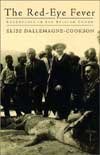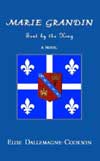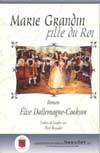Elise Dallemagne-Cookson (1933-2005)
Cherry Valley, NY
Book Reviews
The following books have been reviewed:
The Bearded Lion
Who Roars (1995)
 Critic
Cleveland Moffett writes in The Bulletin - the English
language news magazine of Europe - "Of books about the Congo,
its glorious and sordid history, many, if not most of them, are sentimental,
self-serving, ideological or dishonest, and then, every so often,
along comes a remarkable exception. Room on this short shelf of worthwhile
writing about the dark heart of African must now be found for The
Bearded Lion Who Roars by Elise Dallemagne-Cookson. No disguised
diary or collection of letters home, which so much colonial writing
is, The Bearded Lion Who Roars is written with literary flair.
This gutsy and resourceful young woman from upstate New York knows
how to set a scene, how to describe what she sees and feels, to report
accurately what is happening when her world starts to fall apart.
It is easy to write what is conventionally called a "powerful"
book about the Congo. Many people have done it. The outbreak of violence,
the panic, the massacres and rapes, the United Nations sending in
troops, make exciting reading. What Elise Dallemagne-Cookson has done
is to tell us how it was, the impossible happiness and the inevitable
reckoning, and she makes us believe every word." Critic
Cleveland Moffett writes in The Bulletin - the English
language news magazine of Europe - "Of books about the Congo,
its glorious and sordid history, many, if not most of them, are sentimental,
self-serving, ideological or dishonest, and then, every so often,
along comes a remarkable exception. Room on this short shelf of worthwhile
writing about the dark heart of African must now be found for The
Bearded Lion Who Roars by Elise Dallemagne-Cookson. No disguised
diary or collection of letters home, which so much colonial writing
is, The Bearded Lion Who Roars is written with literary flair.
This gutsy and resourceful young woman from upstate New York knows
how to set a scene, how to describe what she sees and feels, to report
accurately what is happening when her world starts to fall apart.
It is easy to write what is conventionally called a "powerful"
book about the Congo. Many people have done it. The outbreak of violence,
the panic, the massacres and rapes, the United Nations sending in
troops, make exciting reading. What Elise Dallemagne-Cookson has done
is to tell us how it was, the impossible happiness and the inevitable
reckoning, and she makes us believe every word."
A Kliatt critic agreed: "The talented author makes the
diverse countryside and its people come alive. The reader will become
engrossed with the characters and their unique existence. The dangers
involved in the Belgians' forced evacuation are vividly recounted
and make exciting reading."
The Ombu Tree (1998)
 The
Library Journal says, "This lyrical novel has an almost
other-worldly quality to it, and the author successfully maintains
the reader's interest throughout the unusual tale." The
Library Journal says, "This lyrical novel has an almost
other-worldly quality to it, and the author successfully maintains
the reader's interest throughout the unusual tale."
Ines Pardal writing in the Buenos Aires Herald lauded
Dallemagne-Cookson's attention to detail, noting that the work, "should
be widely praised for its verisimilitude, which bespeaks a loving
care for this long-suffering land."
The Filmmaker (2000)
 In
its review, the Buenos Aires Herald lauded Dallemagne-Cookson's
handling of "one of the most controversial, fascinating film/book
subjects from 20th century U.S. life." In
its review, the Buenos Aires Herald lauded Dallemagne-Cookson's
handling of "one of the most controversial, fascinating film/book
subjects from 20th century U.S. life."
Red-Eye Fever
(2002)
 In
the June 5, 2002, issue of The Bulletin, the newsweekly of
the Capital of Europe, Brussels, Belgium, Cleveland Moffett
writes, "The Red-Eye Fever, Adventures in the Belgian Congo,"
is a memoir by Elise Dallemagne-Cookson of her life in the Congo on
a Foreign Service assignment that lasted from 1959 to the eve of the
colony's independence a year later. Dallemagne-Cookson tells what
sounds like a very tall story about crocodile hunting with convincing
relish. She had not been long at her new job when she accepted the
challenge to take a plunge into the jungle to track down the formidable
175-year-old crocodile El Diablo. The sassy young New Yorker takes
him on and lives to tell the tale. The cover photograph shows her
with a gun in one hand, and her foot on El Diablo's scaly back. In
the June 5, 2002, issue of The Bulletin, the newsweekly of
the Capital of Europe, Brussels, Belgium, Cleveland Moffett
writes, "The Red-Eye Fever, Adventures in the Belgian Congo,"
is a memoir by Elise Dallemagne-Cookson of her life in the Congo on
a Foreign Service assignment that lasted from 1959 to the eve of the
colony's independence a year later. Dallemagne-Cookson tells what
sounds like a very tall story about crocodile hunting with convincing
relish. She had not been long at her new job when she accepted the
challenge to take a plunge into the jungle to track down the formidable
175-year-old crocodile El Diablo. The sassy young New Yorker takes
him on and lives to tell the tale. The cover photograph shows her
with a gun in one hand, and her foot on El Diablo's scaly back.
"Not for her the local zoo. "'A zoo? Here?' I was incredulous.
'The whole place is a zoo. The entire country.'" But her guide
explains that 'most of the Belgians living in Leopoldville never get
out into the countryside. They're too scared.' So by going to the
zoo they can get to see at least a gorilla or two, a lion and a few
monkeys before they leave for home."
Writer's Digest, who has selected "The Red-Eye Fever"
for its 2003 Book Award, Life Stories category says "...More
than just a tale of a crocodile hunt, it ("The Red-Eye Fever")
is a peek at a slice of time now gone. The look at the Congo as it
stood on the verge of independence makes for fascinating reading.
The author also wisely focuses her story, just dealing with her stay
in the Congo. This narrowing of the topic adds power to the story.
The writing reflects sensitivity and thoughtfulness, with the author
providing example stories, dialogue and rich details to illustrate
the general point that she is making. In looking at the style of writing,
it is clear that this author has a talent for telling stories. The
look of the book is also compelling, tying in with the idea of life
in another time."
Marie Grandin
- Sent by the King (2003)
 Carl
Waldman, author of Atlas of the North American Indian says:
"Dallemagne-Cookson took me to another world and I feel I have
a much stronger sense of early Canada and historical events...along
with Marie Grandin and other historical figures. The author rose to
the challenge of giving the reader a sense of what life really might
have been like back then. The characters are intriguing and compelling." Carl
Waldman, author of Atlas of the North American Indian says:
"Dallemagne-Cookson took me to another world and I feel I have
a much stronger sense of early Canada and historical events...along
with Marie Grandin and other historical figures. The author rose to
the challenge of giving the reader a sense of what life really might
have been like back then. The characters are intriguing and compelling."
John Tebbel, renown historian and author of The Battle
for North America, says: "In her fifth book, a sweeping historical
novel, Elise Dallemagne-Cookson takes us into the world of French
Canada, where explorers, adventurers, churchmen, and settlers live
in a world of constant struggle, destined not to end until England
emerges triumphant in the Seven Years' War. We see all this through
the eyes of Marie Grandin, whose tangled life begins in 1668 in Orleans,
France, where a talented young girl flees a broken romance to go to
Canada. There she finds love, war, Indians, adventurers, and friends
like La Salle, the great explorer of the American interior, and Count
Frontenac, among many others. It's a tale of high adventure and romance,
told against a backdrop that is one of the most fascinating chapters
in North American history. And Marie herself is an unforgettable heroine."
Juliana L'Heureux comments "Written as if it were a diary,
Dallemagne-Cookson begins the story in 1670, when the heroine Grandin
is sailing from La Rochelle, France aboard the ship Helene de Flessinge.
Extensive research helped Dallegmagne-Cookson describe the details
of daily life in colonial New France portrayed throughout the novel’s
attractive plot. Building on her family’s oral traditions learned
while growing up in Peekskill, New York, Dallemagne-Cookson even spins
a ghost story in her heroine’s plot, probably for the entertainment
value but also because the French settlers, like many other colonials,
were inclined to believe supernatural phenomenon.".
Read the full
article.
 Marie
Grandin - Fille du Roi (2005) Marie
Grandin - Fille du Roi (2005)
Louis-Guy Lemieux, columnist with Le Soleil in Quebec City
wrote a review describing the book and its recent release. The book
was released at the annual meeting of the Beaudet Association on a
day cruise on the St- Lawrence river on August 27, 2005.
Read the review
article (in French).
Other Reviews and Writings About my Work
Back to Top
Copyright ©
2005 - Elise Dallemagne and HappyWebCreations
Last updated:
December 8, 2005
|